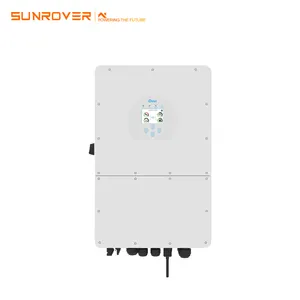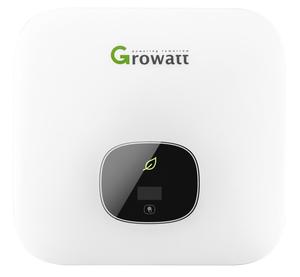(2850 products available)































































































































































































































































Grid-connected solar energy systems utilize various inverters to convert direct current (DC) generated by solar panels into alternating current (AC) that can be fed into the electrical grid. The choice of inverter depends on the specific solar installation and energy production needs.
Commercial and residential grid-tie configurations involve an active collaboration of all electrical devices with the utility grid and operate without battery storage. The generated solar power is directly used within the establishment, and only the surplus energy is transferred to the grid. The grid-tie solar inverters employed in these systems come in the following types:
Central inverters are mainly applied to large-scale solar installations since they are designed to handle a significant amount of power capacity.
These inverters are typically placed in a separate facility rather than mounted on the solar panels themselves. Central inverters receive the direct current (DC) power produced by the solar panels, which is collected in a common point, and converts it into alternating current (AC) power.
Compared to central inverters, string inverters are smaller and more manageable, usually installed in the vicinity of the solar panel arrays. They are the most common type of inverter utilized in commercial and residential solar systems.
String inverters operate by connecting multiple solar panels together in a ""string"" configuration. The DC power generated by each panel is directed to the string inverter, where it is converted into AC power. This AC power is then used to meet the establishment's energy demands, and excess power is sent to the grid.
Microinverters are small inverters affixed to individual solar panels. They convert the DC power generated by each panel into AC power directly on the panel.
This allows each panel to operate independently, which is beneficial in situations where panels may experience varying degrees of shading or have short-term obstructions, such as falling branches or birds. Since each panel functions autonomously, microinverters ensure that the power output remains maximally effective, even in less-than-ideal circumstances.
Hybrid inverters are an integrated solution for systems that combine solar power generation with battery storage. They manage both the real-time solar energy generation and the stored energy utilized for the establishment's consumption during power outages or periods of low solar generation.
Hybrid inverters are compatible with both grid-tie and off-grid configurations, providing flexible energy management based on the specific needs of each installation.
Considering the ever-increasing electricity costs, many companies now embrace the option of generating their own renewable energy, mainly from solar power. As a result, they seek to enhance their sustainability efforts and lower greenhouse gas emissions individually.
Multinational corporations, for instance, select large-scale projects like solar farms to install a grid tie inverter in an array of solar panels and achieve their goal of producing their own clean and cost-effective energy. This development leads them to provide a meaningful environmental impact while ensuring energy price stability.
Thus, increased demand for inverters contributes substantially to the booming renewable energy market.
Companies with inventories and warehousing can maintain a wide range of these solar power inverter products in stock, ready to fulfill orders quickly, especially in this expansive marketplace.
Grid tie inverters can be used for installation along with solar panel systems in any residential, commercial, or agricultural electrical contracting business.
They probably have experience with similar products, such as off-grid MCUs, to integrate with battery-backed, grid-disconnected, or non-isolated systems.
Groups that advocate for policies encouraging renewable energy will always need data on inverter production and sales, as this information is used to support a clean energy framework.
People and groups that install solar arrays typically need a grid tie inverter to convert the entire system into an operating component.
These general contractors commonly add solar systems to their list of services, which creates a need for related components such as inverters.
Utility companies will need to monitor inverter production and sales to manage their grid and ensure they can accept inward power from all customers.
Nonprofits supporting renewable energy access, climate justice, and community education will always need data on inverter sales; this is to assess how many people are benefiting from solar power and where additional support is needed.
Companies that manufacture other components of the solar system, such as panels, batteries, mounts, and charge controllers, may need to pay attention to inverters so they can make compatible products.
Venture capitalists and private equity firms investing in companies that manufacture, distribute, or sell solar inverters would also need to monitor sales data to understand market dynamics and the competitive landscape.
The shipping method for solar inverters purchased in bulk or wholesale deals can be further divided into several arrangements, which include:
Air freight
Air freight is one of the fastest transportation means of carrying solar inverters and associated elements. It is best to use when there is the need to meet a certain quick demand, or the elements ordered are few and belong to a sensitive category.
Ocean shipping
Ocean shipping is popular with importers and exporters because large quantities of goods like solar inverters can be transported economically. It takes longer than air freight, but it's less costly. It's ideal for sending bulk orders of in-wall mounted inverters or other large items.
Ground transportation
Ground transportation using trucks or trains is mostly used for shipments within a specific country or region. It is a flexible means of transportation, with options ranging from large bulk shipments to smaller packages. Using roads is appropriate if the shipment is relatively small or medium-sized and can be delivered within a reasonable time frame.
Express courier
Using express couriers like DHL, FedEx, or UPS is a viable option for small shipments as it entails tracking the shipment down to the delivery point. This is suitable for smaller inverter items or urgent items where documents, invoices, and bills of lading are required.
Standard packaging for bulk purchases of electric grid inverters for solar energy includes the following:
Following the packaging and shipping requirements allow buyers to seamlessly receive their solar inverters:
A sun power grid-tie inverter can be a choice that works with the type of solar panel purchased, whether they are monocrystalline, polycrystalline, or thin film. Most manufacturers provide information on the inverter's compatible panel types.
Both the inverter's power output and the solar array size must be matched to ensure good performance. One basic rule is that the inverter's wattage should be equal to or greater than the total system wattage of the solar panels. However, it should be noted that exceeding the inverter's capacity by more than 25% rarely results in significant ""panel clipping"" - where excess sunlight cannot be converted - because most residential areas receive less than 6 hours of direct sunlight each day.
Live performance checking can be done through a smartphone, tablet, or computer by a built-in or added monitoring system in the grid-tie inverter. A lot of manufacturers offer performance statistics over time, which can assist in comparing energy creation from various sunlight days, detecting output issues, and analyzing the potential need for replacement or repairs to the solar power system. Live performance checking from home makes it easier for homeowners to hire solar professionals for regular solar maintenance with a solar inverter.
Inverter costs vary based on the type, features, and manufacturers. Hybrid inverters are generally pricier than string or micro inverters because they all have battery backup capability. Although, investors should consider their budget limitations and get the regular tied inverter that works within their range. Inverter quality is a crucial aspect that needs to be considered. This means that even if the inverter cost is high, it should not be compromised due to its ability to ensure maximum performance, endurance, and warranty.
Many inverters come with an array of added features and capabilities. For example, integrated power optimizers with microinverters help optimize panel performance. Other inverters have additional functionalities, such as monitoring for temperature, shading, or tilt issues, which will help troubleshoot problems quickly.
As solar panels generate electricity using sunlight, the current it produces is direct current. However, the electrical grid and household appliances operate using alternating current. Therefore, a grid tie inverter function is to convert the direct current to alternating current and then synchronize the current with the grid frequency and voltage.
The benefits include, at no point, a period when the establishment is without power, cost savings on electric bills, and the ability to sell excess power back to the grid, increasing energy independence.
A standard inverter, often called an off-grid inverter, stores solar energy in batteries to utilize it, even when there is no sunlight. A grid-tie inverter doesn't have that capability, hence the name ghana without an I, meaning it requires a power grid to operate.
Yes, it can significantly offset electric bills by providing solar power during daylight hours. Buying and connecting these inverters is worth it financially for many homeowners.
Grid tie inverters have the following limitations: no power during a blackout, the need for direct sunlight, in the absence of shading, and dependence on the utility grid.